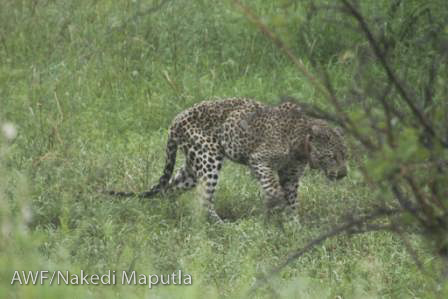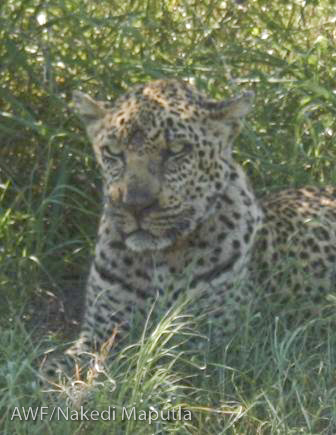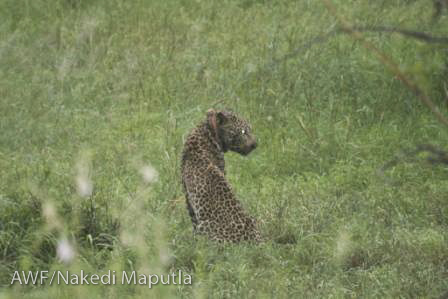The Collared Leopard Not Doing Well - Will He Make It?
The collared leopard is not healthy!
Three weeks ago when I went away on holiday I went out on a few occasions together with the tracking team to track the collared leopard. He seemed to be doing well, but sometimes he looked a bit hungry. At that point I thought he might have been struggling to catch food.
 My collared leopard is thin and struggling.
My collared leopard is thin and struggling.
This was also explained by his constant movements; that is, he had been moving constantly for a number of days. Naturally, this means he was not killing anything big, like an impala for instance. If he would bring an impala down, then he would hang around that area for a number of days before moving on.
A thought arises therefore that the dry season might have kept him going due to a high number of weak prey. Before he was trapped in the cage trap, he visited the cage on three occasions before finally giving in to the temptation, further prompting me to think of him as a struggling leopard.
Then it was time for the impala to drop their young. That could have been providing him with easy food from the hidden impala lambs. I therefore left with the thought that he preferred to feed on smaller animals like impala lambs for instance, which explained his constant movement.
Getting back to our head office in Johannesburg on Thursday January 08th, I called Dr. Sam Ferreira, the Large Mammal Community and Species of Concern Scientist, who also oversees this current project from SANParks, to inform him that I was back and ready to expand the project since we received 20 additional camera traps.
Before I could tell him anything he told me about this collared leopard that looked old which had seen around the Satara area by some tourists. Apparently this leopard was in a very bad shape and to make things worse he had a number of porcupine quills stuck in to his face and neck region.
Sam didn’t have a lot of information, so he suggested I call Dr. Markus Hofmeyr, the Director of Game Capture Unit to confirm. The thought of starting the New Year with a bang started dwindling.
I managed to get hold of Dr. Hofmeyr that evening and he told me that he thought the animal needed attention as the quills prevented him from hunting. After our conversation my holiday plans for the rest of the week were wiped out into oblivion. My plans were to: 1. Arrange to bring a mobile cell phone tower to the study site because of poor reception in the area, which makes it difficult to obtain data from collared animals; 2. Plan the activities of the year and engage my superiors in the process. Talking to them in person beats e-mail and telephone conversations by far; 3. Get most of the administration stuff sorted; 4. Play some basketball; 5. Go clubbing. I wanted to go dancing just once before heading to the bush! 6. Go to the Transvaal Museum (now called the Northern Flagship Institute) to work on some things there; and 7. Take the broken cameras to Pretoria to try and get them fixed.
These plans were then replaced by the new plan: Pack your stuff and go to work!!
That evening I packed my staff, went to the office to fetch the research vehicle and headed to the Kruger National Park, but not without fuelling the car first and getting myself lots of coffee and four Red Bulls!
And so I drove for the whole night and by 04:00am I was at the Kruger Gate. When the gates were opened I made my way to Singita Kruger National Park, got the tracking devices and headed to Satara to hear what the problem was.
I first ran in to the hospitality manager there and he said he had heard the problem was with a cheetah and not a leopard. I was relieved for a second, but something told me that maybe the hospitality manager was not a very good source of information. My thoughts: 1. Leopards and cheetahs are the same thing to a lot of tourists. 2. Some of my friends still think I work with cheetahs, what a shame! 3. The poor guy has to deal with visitors (who probably gave him this information by the way) all day, give him a break. 4. Try the section ranger and hear what she says, and then you can celebrate.
The section ranger confirmed it was indeed a leopard, burying my short-lived excitement. She told me in which direction the leopard was last seen and even suggested I go with one of the guards. The guard and I then headed off to find the leopard. Arriving at the area where he was believed to be I tried his frequency on the telemetry equipment. Results: it was his frequency.
We then actively searched the area and when we found him he looked extremely emaciated. He looked (and still does), like he had not eaten in days. “No wonder some people called him a cheetah,” I thought. This made me sad. He didn’t have the quills on his neck and face anymore. This gave me hope that he might still recover. I’m fighting the urge to show you his pictures.
I then called Dr. Hofmeyr, who came through yesterday (Saturday) morning to have a closer look at the animal. He looked bad, with a swollen face and neck, obviously from the porcupine quills. At that point, I thought how desperate must he have been to attack a porcupine? Is it because he is struggling to catch impalas (and impala lambs)? Dr. Hofmeyr told me that the prognosis of the leopard was not good at all, but he might just make it although he was heavily compromised at that stage.
 Emaciated-leopard.
Emaciated-leopard.
We then had a choice to make: dart the leopard, treat him for the swelling, remove the collar, and let him go or leave him as he is and let him recover on his own. Choosing the former would mean that with his condition we ran the risk of losing him to the anaesthetic. Taking the latter would mean that I will have to monitor him on a daily basis and see what would happen. Here we run the risk that should he not make it and hyenas get to him before I do, all the information from the collar would be lost for good. We chose to let him be and monitor his progress on a daily basis.
In all that bewilderment there were a lot of people who got to see the poor leopard in his frail state. Most of the people were really concerned about the leopard and were (and still are) willing to share their photos of him. I am really sad that he got to be seen in that state, but it happens.
I am as a result monitoring him on a daily basis to see his progress.
 Will he survive?
Will he survive?